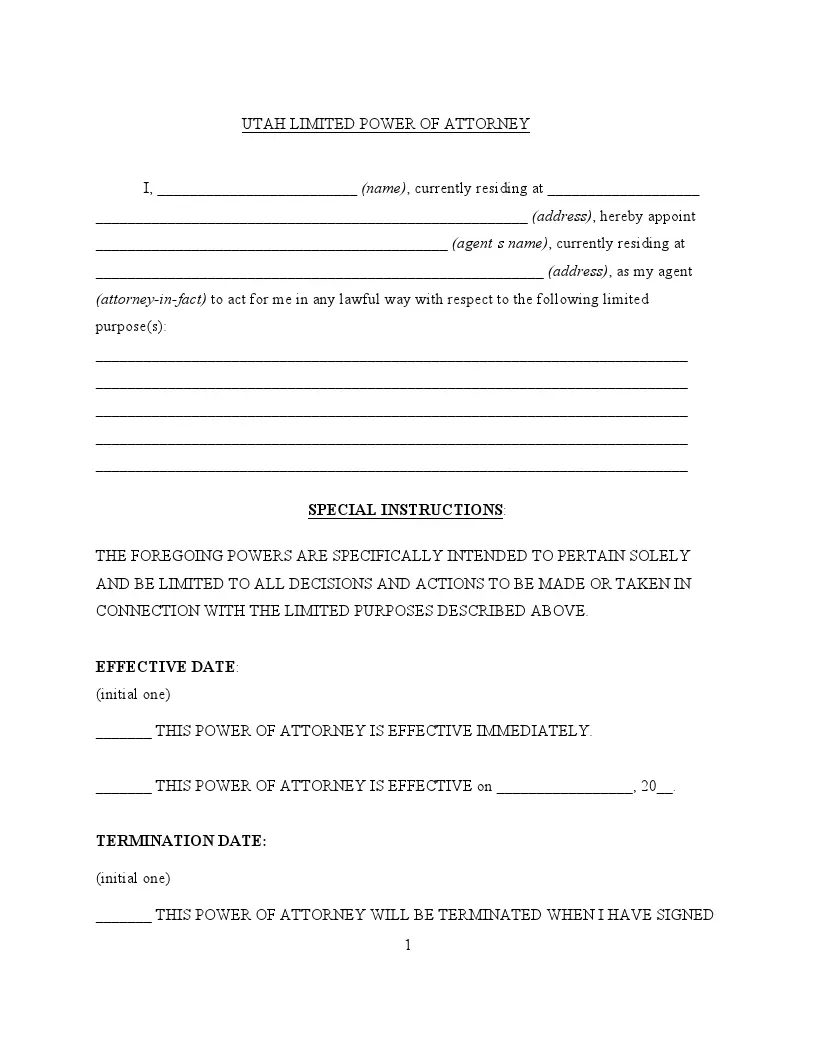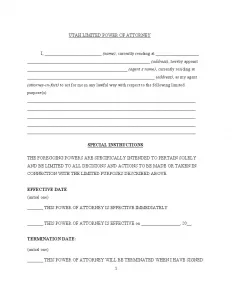Utah Limited Power of Attorney Form
A Utah limited power of attorney is a legal form that authorizes an individual, referred to as the “agent” or “attorney-in-fact,” to perform specific duties on behalf of another person, known as the “principal.” This type of power of attorney is distinct from a general power of attorney, as it confines the agent’s authority to specific activities or decisions. This precision is helpful when the principal is out of Utah and requires an agent to represent them in conducting real estate transactions, overseeing financial dealings, or addressing legal issues.
In Utah, drafting a limited power of attorney must comply with state law. The document must clearly outline the scope and limitations of the agent’s powers, including any special conditions or expiration dates. By the way, you can get all Utah power of attorney forms on FormsPal to handle your legal affairs.

Build Your Document
Answer a few simple questions to make your document in minutes
Save and Print
Save progress and finish on any device, download and print anytime
Sign and Use
Your valid, lawyer-approved document is ready
Executing a limited power of attorney in this state must adhere to specific legal requirements outlined in the Utah Code, Sections 75-9-101 to 75-9-403 (Uniform Power of Attorney Act). This act ensures that the document holds legal validity and can be enforced properly. Essential steps for valid execution include:
- The power of attorney must be in written form and grant explicit authority to an agent as defined by Utah Code, Section 75-9-102.
- According to Utah Code, Section 75-9-105, a notary public must acknowledge the principal’s signature on the power of attorney to affirm the document’s legitimacy.
Complying with these regulations ensures that the limited power of attorney is structured to clearly articulate the agent’s roles and responsibilities under Utah law.
Utah Limited Power of Attorney Form Details
| Document Name | Utah Limited Power of Attorney Form |
| Other Name | Utah Special Power of Attorney |
| Relevant Laws | Utah Code, Section 75-9-201 |
| Avg. Time to Fill Out | 8 minutes |
| # of Fillable Fields | 32 |
| Available Formats | Adobe PDF |
Filling Out Utah Limited POA
Completing a limited power of attorney in Utah grants a trusted agent the authority to act on your behalf in specific legal or financial matters. Below is a step-by-step guide to help you fill out this form accurately.
1. Provide Your Full Name and Address
Start by entering your full name where indicated on the form. Follow this by writing your complete address, including street, city, and zip code, to establish your identity as the principal granting the power.
2. Appoint Your Trusted Agent
Enter the full name of the person you appoint as your attorney-in-fact, followed by their complete address and contact phone number. This individual will be granted the authority to act on your behalf according to the powers specified in the document.
3. Specify the Authority You Are Granting
List the actions or decisions your attorney-in-fact is authorized to perform on your behalf. Be as clear and precise as possible to avoid any potential misuse of the power. This section may include managing certain assets, handling business transactions, or making healthcare decisions.
4. Understand and Accept the Conditions
Review the terms under which your attorney-in-fact agrees to act. This includes acting in your best interest and within the powers granted by you. Make sure you agree with these terms before proceeding.
5. Provide Your Signature and Date
Sign the form to validate it. Enter the date you are signing the form, ensuring that the date reflects when you are physically completing the document.
6. Have the Document Notarized
Take the completed form to a notary public. The notary will witness your signature and fill in the county name, date, and information, including the expiration of their commission. This step is crucial as it authenticates the document.
